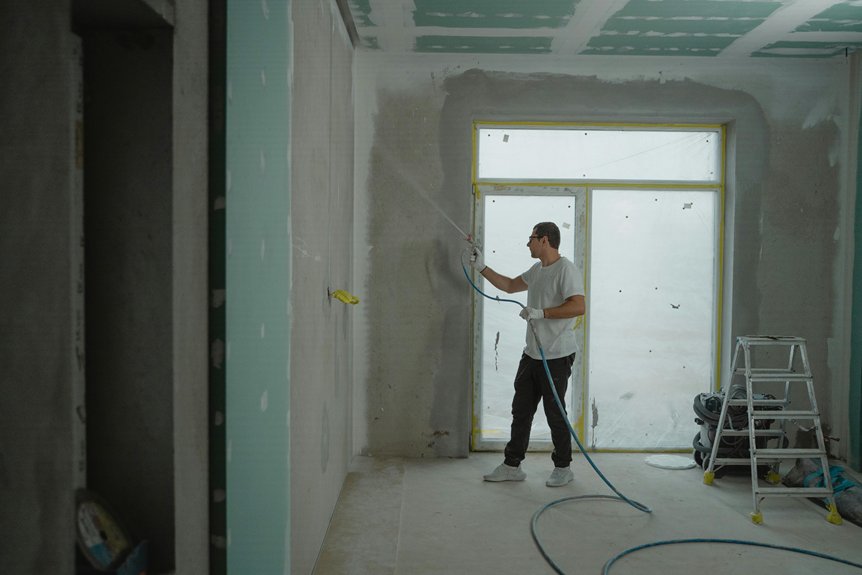Home maintenance plans are essential tools for homeowners looking to manage their properties effectively. They provide a structured approach to routine upkeep, helping you avoid costly repairs and maintain your home’s value. By outlining key tasks and timelines, these plans keep you organized and proactive. But how do they really work, and what should you expect when you enroll in one? Understanding the specifics can make all the difference in your home management strategy.
Key Takeaways
- Home maintenance plans outline essential tasks and timelines to simplify homeowner responsibilities and enhance property value.
- They include regular inspections, seasonal checklists, and documentation of repairs to maintain home functionality and safety.
- Payment options vary, with flexible structures like monthly, quarterly, or annual payments that can lead to long-term savings.
- Plans help prevent costly repairs through early problem detection, ensuring systems operate efficiently and avoiding unexpected expenses.
- Unique home characteristics and lifestyle choices influence maintenance needs, making tailored strategies essential for effective management.
Understanding Home Maintenance Plans

When you’re a homeowner, understanding home maintenance plans can greatly simplify your life. These plans help you manage your homeowner responsibilities by outlining essential tasks and timelines for your property.
By incorporating maintenance scheduling into your routine, you can prevent costly repairs and extend the life of your home’s systems and structures. Regular tasks, like HVAC servicing or gutter cleaning, guarantee everything runs smoothly.
A well-structured maintenance plan not only alleviates stress but also enhances your home’s value. By prioritizing these responsibilities, you set yourself up for a more organized and efficient homeownership experience.
Key Components of a Home Maintenance Plan
A thorough home maintenance plan includes several key components that guarantee your property remains in top condition.
To effectively manage your home, consider these elements:
To effectively manage your home, incorporate regular inspections, essential tools, and meticulous documentation into your maintenance plan.
- Key Maintenance Tasks: Schedule regular inspections, clean gutters, and check HVAC systems.
- Essential Tools: Equip yourself with basic tools like a screwdriver, wrench, and ladder.
- Documentation: Keep a detailed record of repairs, inspections, and warranties.
- Seasonal Checklists: Create checklists for spring, summer, fall, and winter tasks.
How Home Maintenance Plans Work
Home maintenance plans typically offer a range of services tailored to your needs, covering everything from routine inspections to emergency repairs.
You’ll also find various payment structures, allowing you to choose what works best for your budget.
Maintenance visits are scheduled at specific intervals, ensuring your home stays in top shape without you having to worry about it.
Services Included in Plans
Many homeowners benefit from a variety of services included in maintenance plans designed to keep their properties in top shape.
These services often encompass essential tasks that guarantee your home remains functional and safe.
Here are some common service options you can expect:
- Seasonal checkups for HVAC systems to optimize efficiency.
- Roof inspections to identify potential leaks and damage.
- Plumbing checks to prevent leaks and guarantee proper drainage.
- Pest control treatments to keep unwanted visitors at bay.
Payment Structures Explained
How do you choose the right payment structure for your home maintenance plan? Start by evaluating your budget and the payment options available.
Many plans offer monthly, quarterly, or annual payments, allowing for plan flexibility based on your financial situation. Monthly payments might ease cash flow, while annual payments often come with discounts.
Consider your maintenance needs and frequency of services when deciding. Be certain to review any additional fees or hidden costs associated with each option.
Ultimately, choose a structure that aligns with your preferences and guarantees you can maintain your home without financial strain.
Frequency of Maintenance Visits
When should you expect maintenance visits under your plan? Regular visits are essential for a well-maintained home. Typically, you can anticipate:
- Seasonal Checkups: These occur four times a year, ensuring your home is ready for each season.
- Routine Inspections: Expect these bi-annually to identify any issues before they escalate.
- Emergency Visits: Your plan should cover unexpected problems, offering peace of mind.
- Additional Services: Some plans may include extra visits for specialized needs, like HVAC or roofing.
Staying on top of these visits helps you maintain your home’s value and functionality effectively.
Types of Services Included in Maintenance Plans
While you might think of home maintenance plans as just a list of tasks, they typically encompass a variety of essential services designed to keep your home in prime condition.
These plans often include seasonal checks, guaranteeing your HVAC system operates efficiently and your gutters are clear. You’ll also benefit from regular appliance inspections, which help identify potential issues before they become costly repairs.
Other services may cover plumbing checks, electrical system evaluations, and exterior maintenance. By enrolling in a maintenance plan, you can ensure that each aspect of your home receives the attention it needs to function effectively year-round.
Benefits of Enrolling in a Maintenance Plan

Enrolling in a maintenance plan can lead to significant cost savings over time, as regular upkeep helps prevent costly repairs down the line.
You’ll benefit from preventative care that keeps your home in prime condition, extending the life of your systems and appliances.
Investing in a plan means peace of mind, knowing that your home is well-maintained and any issues will be addressed promptly.
Cost Savings Over Time
Investing in a home maintenance plan not only guarantees your property remains in top condition but also leads to significant cost savings over time.
By enrolling, you’ll achieve long-term savings and enhance your budget planning. Here are some ways you’ll save:
- Preventive Maintenance: Regular check-ups reduce costly repairs.
- Discounted Services: Many plans offer reduced rates for covered services.
- Increased Property Value: Well-maintained homes attract higher resale prices.
- Emergency Preparedness: You’ll avoid urgent repairs that can drain your finances unexpectedly.
With a maintenance plan, you’re not just protecting your home; you’re also making a smart financial decision.
Preventative Care Benefits
When you enroll in a home maintenance plan, you gain access to a range of preventative care benefits that keep your home functioning smoothly and efficiently.
These plans focus on preventative maintenance, addressing potential issues before they escalate into costly repairs. Regular inspections and routine service help you maintain your home’s systems, like HVAC and plumbing, ensuring they operate at peak efficiency.
The long-term benefits include increased property value, enhanced energy efficiency, and greater peace of mind. By investing in preventative care, you’re not just saving money; you’re also protecting your home and extending the life of its essential components.
Cost Considerations for Home Maintenance Plans
While evaluating home maintenance plans, it’s crucial to take into account both immediate costs and long-term savings.
To effectively manage your budget, consider these factors:
- Monthly Fees: Review the cost of each plan, ensuring it fits your budgeting strategies.
- Service Frequency: Compare how often services are provided; more frequent visits can save you in the long run.
- Coverage: Assess what’s included—some plans cover more than others, impacting overall value.
- Discounts: Look for potential savings through bundling services or loyalty programs in your plan comparisons.
Balancing these elements will help you make an informed decision.
Choosing the Right Home Maintenance Plan
When choosing the right home maintenance plan, you need to assess your specific needs first.
Consider factors like the age of your home, your lifestyle, and any unique requirements that may influence your maintenance strategy.
Next, compare available options to find a plan that best aligns with those needs and offers the services you value most.
Assessing Your Needs
How do you determine which home maintenance plan suits your unique needs? Start by evaluating your homeowner priorities and seasonal needs.
Consider the following:
- Property Age: Older homes may require more frequent upkeep.
- Location: Different climates affect maintenance frequency and types.
- Lifestyle: Busy schedules might necessitate a more thorough plan.
- Budget: Identify what you can realistically invest in maintenance.
Comparing Available Options
As you explore various home maintenance plans, it’s crucial to compare the features and benefits each option offers to guarantee it aligns with your specific needs.
Look at homeowner experiences and reviews to gauge satisfaction levels and reliability. Pay attention to coverage details, including what services are included, response times, and any exclusions.
Plan comparisons should also consider pricing structures—some may offer monthly payments, while others require an upfront fee.
Evaluate flexibility in services offered, ensuring you can tailor the plan to your home’s unique requirements.
Ultimately, choose a plan that provides peace of mind while fitting your budget.
The Importance of Regular Inspections
While many homeowners overlook the necessity of regular inspections, doing so can save you both time and money in the long run.
By establishing a consistent inspection frequency and using thorough inspection checklists, you can catch issues before they escalate.
Here are four benefits of regular inspections:
- Early Problem Detection: Identify minor repairs before they turn into costly disasters.
- Increased Property Value: Maintain your home’s condition, enhancing resale potential.
- Safety Assurance: Guarantee that all systems function safely and efficiently.
- Budgeting: Plan for future maintenance costs, avoiding unexpected expenses.
Common Misconceptions About Maintenance Plans
Many homeowners mistakenly believe that maintenance plans are unnecessary or only for those with large properties. This planning misconception can lead to costly repairs down the line.
In reality, maintenance plans provide essential, misunderstood services that benefit all homeowners, regardless of property size. They help you stay organized, ensuring that routine tasks like HVAC servicing or gutter cleaning aren’t overlooked.
By investing in a maintenance plan, you’re not just preventing issues; you’re also enhancing your home’s value and longevity.
Don’t let misconceptions keep you from taking advantage of these practical solutions that make homeownership simpler and more efficient.
How to Get Started With a Home Maintenance Plan

Getting started with a home maintenance plan can seem intimidating, but breaking it down into manageable steps makes the process straightforward.
Starting a home maintenance plan may feel daunting, but simplifying it into clear steps makes it easy to manage.
Follow these four steps to tackle your homeowner responsibilities effectively:
- Inventory Your Home: List all major systems and appliances that need regular maintenance.
- Create a Schedule: Use a calendar app or planner for maintenance scheduling, setting reminders for tasks.
- Prioritize Tasks: Identify urgent issues versus routine upkeep to allocate your time wisely.
- Stay Organized: Keep records of completed maintenance and any warranties for easy reference.
With this approach, you’ll guarantee your home remains in top condition.
Conclusion
Incorporating a home maintenance plan into your routine can greatly enhance your property’s longevity and value. By staying organized with regular inspections and timely upkeep, you can prevent costly repairs and guarantee your home remains a safe, comfortable space. Take the time to evaluate your options and choose a plan that fits your needs. With the right maintenance strategy in place, you’ll enjoy peace of mind knowing your home is well cared for and ready for any challenges ahead.




